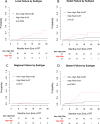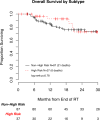Histologic Subtype in Core Lung Biopsies of Early-Stage Lung Adenocarcinoma is a Prognostic Factor for Treatment Response and Failure Patterns After Stereotactic Body Radiation Therapy
- PMID: 27839909
- PMCID: PMC5161605
- DOI: 10.1016/j.ijrobp.2016.09.037
Histologic Subtype in Core Lung Biopsies of Early-Stage Lung Adenocarcinoma is a Prognostic Factor for Treatment Response and Failure Patterns After Stereotactic Body Radiation Therapy
Abstract
Purpose: Stereotactic body radiation therapy (SBRT) has emerged as an effective treatment for early-stage lung cancer. The histologic subtype of surgically resected lung adenocarcinoma is recognized as a prognostic factor, with the presence of solid or micropapillary patterns predicting poor outcomes. We describe the outcomes after SBRT for early-stage lung adenocarcinoma stratified by histologic subtype.
Methods and materials: We identified 119 consecutive patients (124 lesions) with stage I to IIA lung adenocarcinoma who had undergone definitive SBRT at our institution from August 2008 to August 2015 and had undergone core biopsy. Histologic subtyping was performed according to the 2015 World Health Organization classification. Of the 124 tumors, 37 (30%) were a high-risk subtype, defined as containing a component of solid and/or micropapillary pattern. The cumulative incidences of local, nodal, regional, and distant failure were compared between the high-risk and non-high-risk adenocarcinoma subtypes using Gray's test, and multivariable-adjusted hazard ratios (HRs) were estimated from propensity score-weighted Cox regression models.
Results: The median follow-up for the entire cohort was 17 months and for surviving patients was 21 months. The 1-year cumulative incidence of and adjusted HR for local, nodal, regional, and distant failure in high-risk versus non-high-risk lesions was 7.3% versus 2.7% (HR 16.8; 95% confidence interval [CI] 3.5-81.4), 14.8% versus 2.6% (HR 3.8; 95% CI 0.95-15.0), 4.0% versus 1.2% (HR 20.9; 95% CI 2.3-192.3), and 22.7% versus 3.6% (HR 6.9; 95% CI 2.2-21.1), respectively. No significant difference was seen with regard to overall survival.
Conclusions: The outcomes after SBRT for early-stage adenocarcinoma of the lung correlate highly with histologic subtype, with micropapillary and solid tumors portending significantly higher rates of locoregional and metastatic progression. In this context, the histologic subtype determined from core biopsies is a prognostic factor and could have important implications for patient selection, adjuvant treatment, biopsy methods, and clinical trial design.
Copyright © 2016 Elsevier Inc. All rights reserved.
Conflict of interest statement
Dr. Rimner receives research funding from Boehringer Ingelheim and Varian Medical Systems.
Figures
References
-
- Devesa SS, et al. International lung cancer trends by histologic type: male:female differences diminishing and adenocarcinoma rates rising. International journal of cancer. 2005;117(2):294–9. - PubMed
-
- Youlden DR, Cramb SM, Baade PD. The International Epidemiology of Lung Cancer: geographical distribution and secular trends. Journal of thoracic oncology: official publication of the International Association for the Study of Lung Cancer. 2008;3(8):819–31. - PubMed
-
- Asamura H, et al. A Japanese Lung Cancer Registry study: prognosis of 13,010 resected lung cancers. Journal of thoracic oncology: official publication of the International Association for the Study of Lung Cancer. 2008;3(1):46–52. - PubMed
-
- Goldstraw P, et al. Non-small-cell lung cancer. Lancet. 2011;378(9804):1727–40. - PubMed
-
- Travis WD, et al. International association for the study of lung cancer/american thoracic society/european respiratory society international multidisciplinary classification of lung adenocarcinoma. Journal of thoracic oncology: official publication of the International Association for the Study of Lung Cancer. 2011;6(2):244–85. - PMC - PubMed
Publication types
MeSH terms
Grants and funding
LinkOut - more resources
Full Text Sources
Other Literature Sources
Medical



